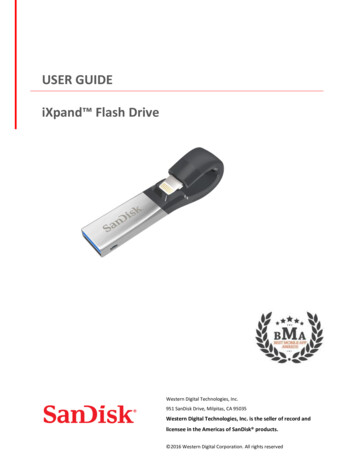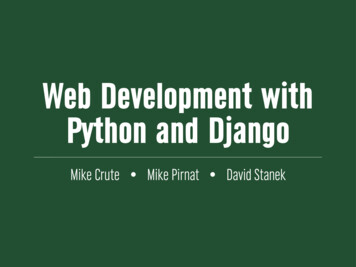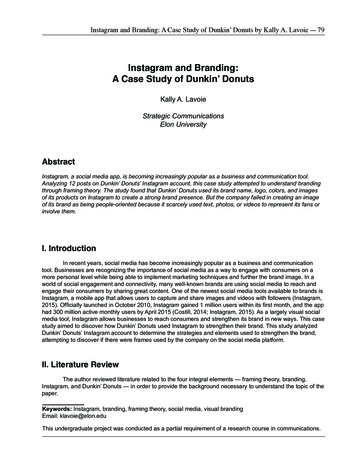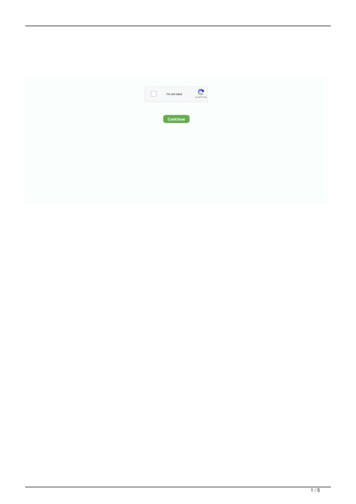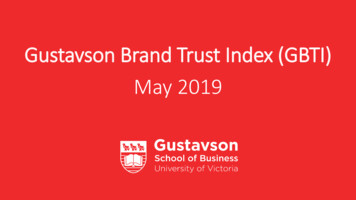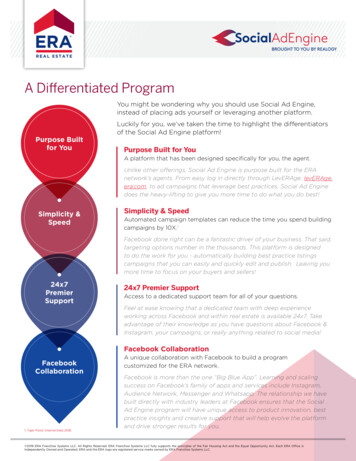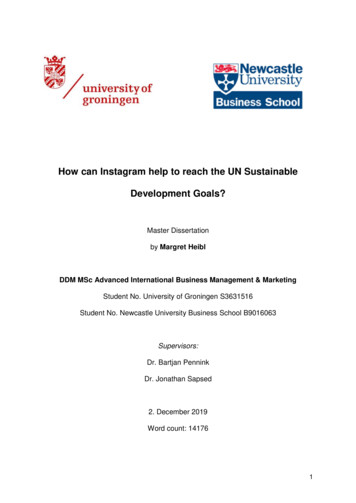
Transcription
How can Instagram help to reach the UN SustainableDevelopment Goals?Master Dissertationby Margret HeiblDDM MSc Advanced International Business Management & MarketingStudent No. University of Groningen S3631516Student No. Newcastle University Business School B9016063Supervisors:Dr. Bartjan PenninkDr. Jonathan Sapsed2. December 2019Word count: 141761
ACKNOWLEDGMENTSFirst of all, I want to express my gratitude to my supervisors Dr. Bartjan Pennink of theUniversity of Groningen and Dr. Jonathan Sapsed of the Newcastle UniversityBusiness School. The comments and feedback were always quick and useful when Iwas facing difficulties during the process of writing. The remarks contributedsignificantly to the learning process of this master thesis.But most of all, I thank my sister and my best friends to be there for me in the lastmonths while writing this thesis. I am especially grateful for all the bottles of wine thathad to be opened due to a crisis on my side caused by this paper. I thank my mum,my grandparents and my cousine to constantly believe in the fact that I somehow willfinish my studies, even though I sometimes could not believe in it. It was a tough timeand I can ensure to all those people above, I will never do it again.ABSTRACTSocial Media platforms are on the rise and Influencer gain importance. More and morebusiness co-operate with them in order to use their wide range of followers to promoteproducts or services. While the popularity of Influencer is used as a Marketing Tool forbusinesses, it became a role model for teenagers and young adults, as well as grownups. Technology is on the rise, while the environmental situation shows little to noimprovement. The world is within a climate crisis and the UN Sustainable DevelopmentGoals (SDG) was created to solve this. Unfortunately, countries struggle to meet theunderlying goals. This thesis concentrates on the possible use of the platformInstagram to meet the SDGs with motivating followers to actively change theirbehavior. For that reason, an online survey with Influencer was conducted to gaininsights in the possible ways Social Media can help to meet the SDGs. The findingsshow that Instagram is a suitable platform for this sustainable experiment, but only ifchanges happen on the managerial, as well as on the Influencer side happen.2
TABLE OF CONTENTACKNOWLEDGMENTS2ABSTRACT2TABLE OF CONTENT3List of Appendices4List of Tables4List of Figures5List of Abbreviations6INTRODUCTION71.1 Problem Discussion81.2. Purpose81.3. Research Question8PART I: LITERATURE REVIEW1.1. The Power of Social Media991.2. Instagram111.3. The creation of Influencer122.3. Influencer Marketing131.3.1. The authentic Influencer151.3.3. Demographic Reach161.4. Hashtivism182.1. UN Sustainable Development Goals202.2. From MDGs to SDGs202.2. Goal Number 12 & 14222.2.1. Responsible Consumption and Production232.2.2. Fast Fashion242.2.3. Life Below Water262.3. SDG - World RankingPart II: METHODOLOGY3. Methodological approach2730303.2. Survey Structure323.3. Analysis & Participants343.4. Ethical Considerations354. Findings4.1. Background information of the participating party35363
4.2. Authenticity384.3. Sustainable Role on Instagram424.3. Fast Fashion & Goal Number 12434.5. Life below water & Goal number 14464.6. Incentives & Remuneration49Part III: Findings505.1. Key Findings505.1.1. How authentic are Influencer?505.1.2. How do Influencers see their role regarding sustainability, do they believeInstagram can help in this issue?505.1.3. What is the understanding of Fast Fashion?505.1.4. Plastic Reduction515.1.5. Does it need monetary incentives?515.2. Implications515.2.1. Theoretical Implications515.2.2. Practical, Managerial and Societal Implications525.3. Discussion & Conclusion52References:54APPENDIX60List of AppendicesAppendix A: Survey Matrix (Open-End Questions)57Appendix B: Coding Process Matrix58List of TablesTable 1: Differences between MDGs and SDGs (UNDP, 2017)18Table 2: Question 2 - SDG Index and residential country of participants324
List of FiguresFigure 1: Rise of Instagram’s Revenue Share (Source: Statista 2019)8Figure 2: Influencer Marketing before Social Media9Figure 3: Categories of Influencer (Source: Mediakix.com)11Figure 4: Potential Age Reach of an Influencer (Gläsemann & Lau, 2019)13Figure 5: The Millennium Development Goals (UNDP, 2017)17Figure 6: The Sustainable Development Goals (UNDP, 2017)17Figure 7: SDG Index Rank 201824Figure 8: Research Design Thesis25Figure 9: Relationship between RQ and Survey29Figure 10: Question 4 - Number of Followers33Figure 11: Question 9 - Professional content and personal beliefs37Figure 12: Question 10 - Sustainable Awareness37Figure 13: Question 11 - Instagram community38Figure 14: Question 13 - Role of Fast Fashion39Figure 15: Question 14 - Amount of samples40Figure 16: Question 15 - Use of Fashion samples41Figure 17: Question 17 - Plastic Pollution43Figure 18: Question 18 - Participant’s reaction445
List of AbbreviationsEPAEnvironmental Protection AgencyEUEuropean Unione-WOMelectronic Word of MouthGen ZGeneration ZMDGMillennium Development GoalsRQResearch QuestionSDGSustainable Development GoalsSISocial InfluencerSQSub questionSDSNSustainable Development Solutions NetworkUNUnited NationsUSUnited States of AmericaWCEDWorld Commission on Environment and DevelopmentWOMWord of Mouth6
INTRODUCTIONIn a study in 2017 it was revealed that teenager spend a total of nine hours daily online.Within these hours, 30% are spent on Social Media platforms, like for exampleFacebook, Instagram or Twitter. This percentage equals 2.7 hours a day (Asano,2018). Driven by this fact, more and more businesses use these platforms as amarketing tool to reach their audience. In general, Social Media is available toeveryone with a working internet connection. Consequently, the world is online, whichmakes it easier to reach more people in different countries. Caused by this highintercultural connection and the possibility to reach a wide range of people throughone post on Social Media, more and more businesses use Social Media to promotetheir products or services. Essential in this marketing process are the power ofInfluencers. A Social Media Influencer is “a state of being famous to a niche group ofpeople” (Marwick, 2013, in Abidin & Ots, 2016, p.3).Two years before the above mentioned study was published, the United Nations (UN)put the Sustainable Development Goals (SDGs), as an agenda for sustainable changeto be achieved by 2030, is in place. As a result, countries worldwide started to rethinklegal and social standards to create sustainable change towards the SDGs.Nevertheless, the underlying problem is that the majority of countries fail to makesufficient commitment to reach the UN SDGs. Although there is numerous literatureabout the UN agenda, it lacks the interlinkage with Social Media platforms, “butsuccess will not be possible without social activism that mobilizes stakeholders andchange norms to enable the SDG transformation” (Geus & Sachs, 2019 p.2).This thesis is based on the idea that Social Media can be used as a platform, wherecompanies and a wide audience can create sustainable change. Additionally, thedifferent platforms will be seen as a place where companies and Influencer can worktogether on sustainable solutions.As research on Social Media Influencer hasindicated that using their follower base generates access to a large audience, it wasidentified that within this reach lies the power to persuade other (Bathelot, 2015). Theemphasis of this thesis will be to demonstrate how the technology and the use of apopular platform like Instagram can make the subject “sustainability” more interestingand “graspable” again.7
1.1 Problem DiscussionAfter reviewing the available and published research within the field of InfluencerMarketing, a gap of research was identified: although, there is various literature onSocial Media or the SDGs, the possible impact and effect of Social Media platforms topromote sustainable change is yet unexplored. This thesis aims to show how the reachof Social Media can be used for sustainable marketing strategies and to connect withthe young generation.Through the last 10 years, internet and Social Media platforms gained importance, theway in which people communicate with each other and companies with theircustomers has changed enormously. Consequently, virtual relationships becamenormal and are used for business models or marketing strategies. The rise of thephenomenon “Social Media Influencer” over the last years let to a shift within the socialmedia platforms and created a business model available for everyone. With the usageof profiles and their underlying follower base, companies use their reach to promotetheir products. This development is subject of divergent opinions. On the one side, thismarketing tool is a fast way to promote the product within a wide range, but on theother side, it is often used for fast fashion product placements and unsustainablepurchasing choices.Due to the absence of research on the above indicated field of Social Media influenceand reaching the SDGs, the thesis concentrates on the further investigation andexploration of the possible impact of this influence.1.2. PurposeThe purpose of the thesis is to analyse to what extent Instagram can be used as aplatform for sustainable change towards the UN Sustainable Development Goals.Furthermore, the analysis points out how far Influencer are informed about specificSDGs and if they show willingness to use their professional profiles to promotesustainable change to a wider audience.1.3. Research QuestionRQ: How can Instagram help to reach the UN Sustainable Development Goals?8
Based on the Research Question (RQ) are the following sub-questions (SQ), thatoutline the areas of interest that are meant to answer the underlying question of thethesis.Sub-questions:SQ1: How authentic are Influencers?SQ2: How do Influencers see their role and impact regarding sustainability?SQ3: How do Influencers define and understand Fast Fashion?SQ4: Can Influencers on Instagram help to promote plastic reduction. If so,how?SQ5: Do Influencers require monetary incentives to promote sustainabilitygoals?PART I: LITERATURE REVIEW1.1. The Power of Social MediaWith the raise of the internet, the ability increased to give like-minded people a placeto communicate and share content worldwide. Social Media platforms gain importancefor teenagers, young adults and brands to connect, communicate and follow eachother. Created by this form of communication tool is a new form of celebrity, called anInfluencer. As this term will be elaborated in detail in the following chapters, theprocess of people being influenced by Social Media is essential to understand.In 2005 the first adoption to track Social Media activities was made. At that time only5% of American adults used those platforms. Six years later this number was ten timeshigher and in 2011, up to 50% in America used at least one Social Media platform.Nowadays, 90% worldwide use social media platforms (Aslam, 2019). Thisdevelopment generated change in the field of role models, as Influencer gainedimportance for the youth and adults. In the following argument the power of SocialMedia is demonstrated by the influence it can have on the purchasing behaviour of anInfluencer’s followers.9
In principal, research stats that the consumption of products is based on the humandesire to express meaning and to create an identity. This desire is based on the wishto have an individual identity expressed by, for example, fashion. Nevertheless, thisindividuality still needs to fit within the social norms (Thompson & Haytko, 1997;Murray, 2002). In a different aspect, Kotler et al. (2016, p.179) define the consumer’spurchasing behaviour as “the study of how individuals, groups, and organisationselect, buy and dispose of goods, services, ideas or experiences to satisfy their needsand wants.” To link these drives for self-identification and expression, the authorsidentified three factors that impact the buying behaviour: There are “cultural” factors,like a person’s desire and behaviour, and consumer’s “personal” factors, like age,income or the current stage in the life cycle. The third factor, described as “social”factor refers to the effect of family, reference groups and social roles on the purchasingbehaviour. Especially the reference groups can be equaled with the “opinion leaders”of Influencer Marketing, as described in detail later.Mary Douglas implied that the preferences of the individual are formed dynamicallythroughout the interaction between people. Additionally, “decisions made in thehousehold and the supermarket about consumption cannot be viewed as technicallyneutral events – they are inextricably linked with values and social meaning and aresignifiers of cultural allegiance and social relationships.” (Douglas and Isherwood1996, p.57).Simultaneously, the way of how advertising gets perceived on Social Media platformschanged fundamentally. The author Joel Backaler distinguishes in his book “DigitalInfluence” (2018) the idioms “Influencer Marketing” and “Interruption Marketing”. Thelatter describes advertising that pops up on your screen and interrupts your reading orwatching of a video on your device. People mostly get annoyed by it, mute it and inthe end ignore it. The message of the advertisement does not stick with the viewer(Backaler, 2018). However, the first form describes a situation where a person getsattracted by the products an Influencer shows or has on Social Media. How the boundbetween and Influencer and a follower can be so strong that behavioural change canhappen will be described in the following chapters.It is beyond the scope of this research to provide detailed analysis of all Social Mediaplatforms and their effects. It is not feasible in the given time and space to strain thisresearch to adequately introduce and discuss other platforms, like Facebook, Twitteror YouTube, appropriately. Therefore, Instagram was selected as representative10
Social Media platform in which Influencers can spread their message to their followerbase. Being one of the most prominent platforms at the moment it seems appropriateto choose Instagram as a starting point for this type of research.1.2. InstagramThe number of globally active users of this mobile photography application is 3.3billion, which equals a penetration of 42%. Only in 2018, the platform gained nearly 1million users. The app was launched in 2010 by Systrom and Krieger and soon afterthat, it was reported as the “fastest growing media among mobile-savvy users” (AwYeong, 2013, in Abidin, 2015, p.6). This innovation on the Social Media market, wasacquired by Facebook two years after the launch for one billion dollars.In 2016, Instagram generated 1.53 billion dollars through mobile ad revenues. Mobilead revenue is the monetary benefit that an app generates with the advertisement theapp is showing on it (ironSource 2019). Research expected the Social Media platformto rise by 18% of revenue shares in 2018. This percentage would represent 5 billiondollars. Now, the platforms ad revenues are expected to be over 14 billion dollars(Aslam, 2019). The online website “Statista” calls Instagram “an online advertisinggoldmine for the social network.” (Statista 2019). The graph below shows the past andfuture estimate of net advertising revenue of Instagram as a percentage of theadvertising revenue of Facebook from 2016 to 2021 in the United States (US).11
Figure 1: Rise of Instagram’s Revenue Share (Source: Statista 2019)This high ad revenue is caused by the fact that businesses prefer having their adcollaborations on this platform. Brands can reach a bigger range of people with usingthe app as advertising platform, directly or indirectly through Influencer marketing. In2019, more than 60% of the active users on Instagram stated that they discoverednew innovations and products through the app (Aslam, 2019).1.3. The creation of InfluencerAs the term “Influencer” gets more important in today’s society, it is interesting to seethat the usage of “normal people”, instead of celebrities was popular long before SocialMedia platforms. The author Brian Mechem showed that it was a common way beforeInstagram or other mediums to use the face of a celebrity or a “normal” person to buildup a brand. This has already started in 1890 with Nancy Green being on the packageof “Partly Pancakes”. Another example is the cigarette brand Marlboro, where thecompany decided in 1950 to build up an image of a “macho” who smokes their brandof cigarette as a symbol for masculinity. Little changed over the years, only that the12
print media got replaced by Social Media and nowadays every person has the potentialto become a testimonial for a brand quick and “out of home” (Mechem, 2018).Using non-famous people to promote a product creates a level of identification. Peoplesee themselves in the person who advertises it and therefore can relate to it more. Inthe past print medias influenced the prospective buyers by showing a stiff picture.Figure 2: Influencer Marketing before Social Media (Mechem, 2018)Nowadays, print media is replaced by social media and the stiff picture of the past isnow an Instagram post or story. The relatable people like a Marlboro Man or NancyGreen, can now be everyone, who invests a lot of time in their profile on Social Mediachannels.2.3. Influencer MarketingThe term Influencer refers to “a person with the ability to influence potential buyers ofa product or service by promoting or recommending the items on social media,particularly when they do so in exchange for money or for samples of the product they13
are promoting” (Pritchett, 2018). The researcher Aslam (2019) revealed that InstagramInfluencers can earn up to 100,000 for a single sponsored post. One post or storyuploaded on Instagram has the potential to reach 802 million people around the globesimultaneously, without any personal connection between the sender and the receiver.Pehlivana et al. (2015) describe this form of marketing as “stealth” as it “purposefullyinfluence audiences without the audiences being aware of these activities” (Charry,2017, p.7). Moreover, the conversion rate on Social Media Influencer generatedcontent is 4.8% higher than through other advertising strategies on the platform. Aconversion rate can be defined as “the percentage of users who take a desired action.The archetypical example of conversion rate is the percentage of website visitors whobuy something on the site” (Nielsen, 2013).In general, an Instagram post can be a personalized form of promotion for a brand orcompany, which gets posted by an “opinion leader”. Keller et al. (2016) define this formof leader as “a person who offers informal advice or information about a specificproduct or product category, such as which of several brands is best or how a specificproduct may be used.” There are furthermore different stages of influencers, forexample Nano-, Micro-, Mid-Tier- or even Mega-Influencer. The distinction betweenthem is the range of people they can reach with a post, which is determined by theirnumber of followers.Figure 3: Categories of Influencer (Source: Mediakix.com)“Our language data shows that influencer now often appear in compounds. As well asdemonstrating the platform which is used – with combinations such as Social-MediaInfluencer, Instagram Influencer, YouTube Influencer, or Vine Influencer proving to be14
amongst the most common” (Pritchett, 2018), meaning that the term Influencer is notcentered on one social media platform, but spread between different mediums.One advantage of Instagram is the new form of relationship that can be built betweenthe brand, the Influencer and the possible buyer. The influencer has the option tointeract with the followers instantly and directly. Especially when an Inf
DDM MSc Advanced International Business Management & Marketing . everyone with a working internet connection. Consequently, the world is online, which . marketing tool is a fast way to promote the product within a wide range, but on the other side, it is often used for fast fashion product placements and unsustainable .



